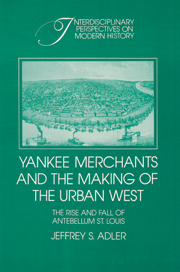Book contents
6 - A border city in an age of sectionalism
Published online by Cambridge University Press: 14 September 2009
Summary
The midcentury boom – and the social changes that it generated – reinforced the Northeast's claim on St. Louis and St. Louis's dependence on the Northeast. Although geographical factors contributed significantly to the city's development, St. Louis continued to owe much of its prosperity to New York and Boston entrepreneurs. Well into the 1850s Yankee perceptions of the city – as a Yankee outpost in the West – sparked the investment and migration decisions that linked the western trading center to sources of capital, business expertise, and cultural institutions on the Atlantic coast. Ironically, the surge in the population, the expansion of the marketplace, and the maturation of local society exaggerated St. Louis's colonial relationship with the Northeast and exposed the city to the instability inherent in such a relationship. Any changes in northeastern perceptions of St. Louis threatened to upset the ties that fueled the city's economic ascent.
The extraordinary pace of growth masked important elements of continuity. During the late 1840s the local population increased by nearly 120 percent, and by 1852 the city held more than ninety thousand residents. The influx of newcomers, the subdivision of vacant tracts into bustling residential areas, the formation of cohesive neighborhoods, and the settlement of the Mississippi valley altered the local economy.
- Type
- Chapter
- Information
- Yankee Merchants and the Making of the Urban WestThe Rise and Fall of Antebellum St Louis, pp. 110 - 144Publisher: Cambridge University PressPrint publication year: 1991



